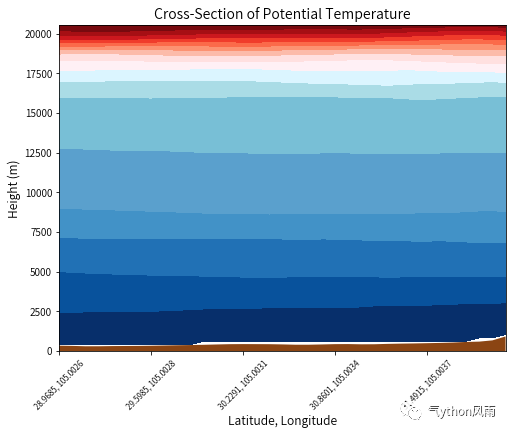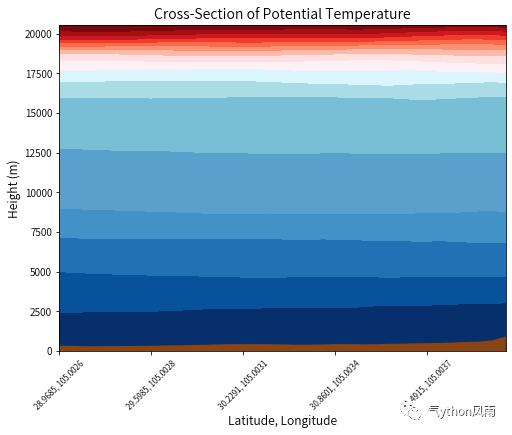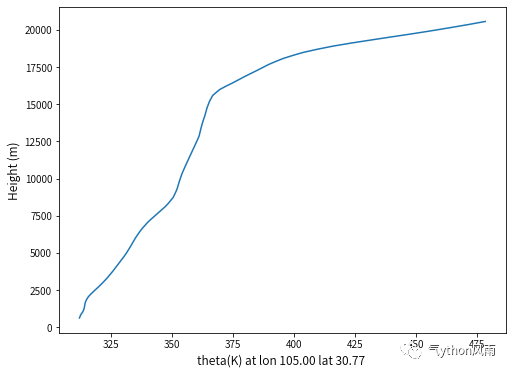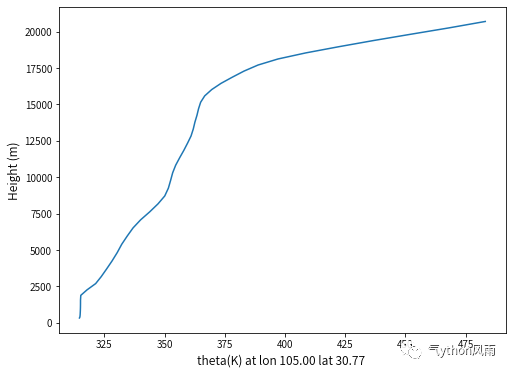WRFOUT 位温剖面和位温单格点高度图
WRFOUT 位温剖面和位温单格点高度图
前言
WRF (Weather Research and Forecasting Model) 是一种广泛用于天气预报和气候模拟的数值大气模式。通过分析WRF模型的输出数据,我们可以获得各种天气变量的空间分布及其随时间的演变情况。
在分析WRF模型输出数据时,常常需要绘制位温(Potential Temperature)剖面和位温单格点的高度图。位温是指将气块从参考高度(通常为1000 hPa)抬升或降低到某个特定高度后的温度,它是大气中的一个重要物理量,能够反映气块的垂直运动特征。
绘制位温剖面可以帮助我们理解大气的垂直结构和稳定性情况。通过观察不同高度上的位温值,我们可以推断出对流层中的温度递减率、大气边界层的稳定性等信息。而绘制位温单格点的高度图,则能够更直观地展示不同位置的位温分布及其随高度的变化趋势。
在本文中,我们将使用WRF模型的输出数据,利用Python编程语言以及相关库(如wrf-python、numpy和matplotlib)绘制位温剖面和位温单格点的高度图。我们将根据指定的站点位置和要绘制的高度层,获取相应的位温数据,并将其在图像中进行可视化展示。通过这样的绘图分析过程,我们可以更好地理解大气垂直结构以及不同位置的温度特征,为天气预报和气候研究提供有价值的参考。
位温剖面
导入库与读数据
from wrf import to_np, getvar, interplevel, get_cartopy, latlon_coords,ALL_TIMES,CoordPair,vertcross,interpline,ll_to_xy
import numpy as np
from netCDF4 import Dataset
import xarray as xr
from metpy.units import units
import matplotlib.pyplot as plt
from matplotlib.cm import get_cmap
from matplotlib.colors import from_levels_and_colors
import cmaps
from glob import glob
import metpy.calc as mpcalc
import metpy.constants as constants
import os
# 定义 WRF 文件夹路径和文件名前缀
wrfout_path = "/home/mw/input/wrfout3385/"
filename_prefix = "wrfout_d02_"
wrf_files = sorted([os.path.join(wrfout_path, f) for f in os.listdir(wrfout_path) if f.startswith(filename_prefix)])
wrf_list = [Dataset(f) for f in wrf_files]使用函数插值剖面
cross_start = CoordPair(lat=29, lon=105)
cross_end = CoordPair(lat=32, lon=105)
theta = getvar(wrf_list[5], 'theta')
ht = getvar(wrf_list[5], "z")
ter = getvar(wrf_list[5], "ter")
theta_cross = vertcross(theta, ht, wrfin=wrf_list[1],
start_point=cross_start,
end_point=cross_end,
latlon=True, meta=True)
ter_line = interpline(ter, wrfin=wrf_list[5], start_point=cross_start,
end_point=cross_end)
# Get the height coordinate values
xs = np.arange(0, theta_cross.shape[-1], 1)
ys = to_np(theta_cross.coords["vertical"])填充
theta_cross_filled = np.ma.copy(to_np(theta_cross))
for i in range(theta_cross_filled.shape[-1]):
column_vals = theta_cross_filled[:,i]
first_idx = int(np.transpose((column_vals > -200).nonzero())[0])
theta_cross_filled[0:first_idx, i] = theta_cross_filled[first_idx, i]绘图部分(无填充版本)
# Get the height coordinate values
xs = np.arange(0, theta_cross.shape[-1], 1)
ys = to_np(theta_cross.coords["vertical"])
# Create the figure
fig, ax = plt.subplots(figsize=(8, 6))
# Plot the theta cross section
contours = ax.contourf(xs,ys,
to_np(theta_cross),
levels=np.arange(300,500,10),
cmap=cmaps.temp_19lev)
# Fill in the mountain area
ht_fill = ax.fill_between(xs, 0, to_np(ter_line),
facecolor="saddlebrown")
# Set the x-ticks to use latitude and longitude labels
coord_pairs = to_np(theta_cross.coords["xy_loc"])
x_ticks = np.arange(coord_pairs.shape[0])
x_labels = [pair.latlon_str() for pair in to_np(coord_pairs)]
# Set the desired number of x ticks below
num_ticks = 5
thin = int((len(x_ticks) / num_ticks) + .5)
ax.set_xticks(x_ticks[::thin])
ax.set_xticklabels(x_labels[::thin], rotation=45, fontsize=8)
# Set the x-axis and y-axis labels
ax.set_xlabel("Latitude, Longitude", fontsize=12)
ax.set_ylabel("Height (m)", fontsize=12)
# Add a title
ax.set_title("Cross-Section of Potential Temperature", fontsize=14)
plt.show()/opt/conda/lib/python3.7/site-packages/cmaps/cmaps.py:3869: UserWarning: Trying to register the cmap 'temp_19lev' which already exists.
matplotlib.cm.register_cmap(name=cname, cmap=cmap)
绘图部分(填充版本)
# Get the height coordinate values
xs = np.arange(0, theta_cross.shape[-1], 1)
ys = to_np(theta_cross.coords["vertical"])
# Create the figure
fig, ax = plt.subplots(figsize=(8, 6))
# Plot the theta cross section
contours = ax.contourf(xs,ys,
to_np(theta_cross_filled),
levels=np.arange(300,500,10),
cmap=cmaps.temp_19lev)
# Fill in the mountain area
ht_fill = ax.fill_between(xs, 0, to_np(ter_line),
facecolor="saddlebrown")
# Set the x-ticks to use latitude and longitude labels
coord_pairs = to_np(theta_cross.coords["xy_loc"])
x_ticks = np.arange(coord_pairs.shape[0])
x_labels = [pair.latlon_str() for pair in to_np(coord_pairs)]
# Set the desired number of x ticks below
num_ticks = 5
thin = int((len(x_ticks) / num_ticks) + .5)
ax.set_xticks(x_ticks[::thin])
ax.set_xticklabels(x_labels[::thin], rotation=45, fontsize=8)
# Set the x-axis and y-axis labels
ax.set_xlabel("Latitude, Longitude", fontsize=12)
ax.set_ylabel("Height (m)", fontsize=12)
# Add a title
ax.set_title("Cross-Section of Potential Temperature", fontsize=14)
plt.show()
位温格点高度图
方法一
theta_s = theta_cross[:,20]
theta_s
可以看出从剖面取出的值还是有对应的经纬度,可直接绘制单格点高度分布
fig, ax = plt.subplots(figsize=(8, 6))
ax.plot(theta_s,ys)
ax.set_xlabel("theta(K) at lon 105.00 lat 30.77 ", fontsize=12)
ax.set_ylabel("Height (m)", fontsize=12)
Text(0, 0.5, 'Height (m)')
方法二
#指定要提取的经纬度坐标点
lat_lon = [30.769948959350586, 105.00334167480469]
#将经纬度坐标转换为模型坐标系(x, y)
x_y = ll_to_xy(wrf_list[5], lat_lon[0], lat_lon[1])
#读取数据
theta_s2 = getvar(wrf_list[5], "theta", timeidx=0)[:, x_y[0], x_y[1]] * units.degC
h = getvar(wrf_list[5], "height", timeidx=0)[:, x_y[0], x_y[1]] * units.degC
# plot
fig, ax2 = plt.subplots(figsize=(8, 6))
ax2.plot(theta_s2,h)
ax2.set_xlabel("theta(K) at lon 105.00 lat 30.77 ", fontsize=12)
ax2.set_ylabel("Height (m)", fontsize=12)Text(0, 0.5, 'Height (m)')
差别
乍一看没差别,实际上两者的shape是不同的
theta_s.shape,theta_s2.shape((100,), (49,))剖面取的点是插值之后的,层数达100,而直接取的单格点仅有模式设置的49层。 这单点高度图只是随手之作,大家有更好的办法可以评论区讨论讨论。
小结¶
做得仓促,没有细化绘图。从剖面再取格点貌似绕了远路(难道我会告诉你只是剖面图的副产物吗)
这时候有同学要问了,这地形图怎么这么难看啊?都说是仓促作图。废话少说赶紧点赞。